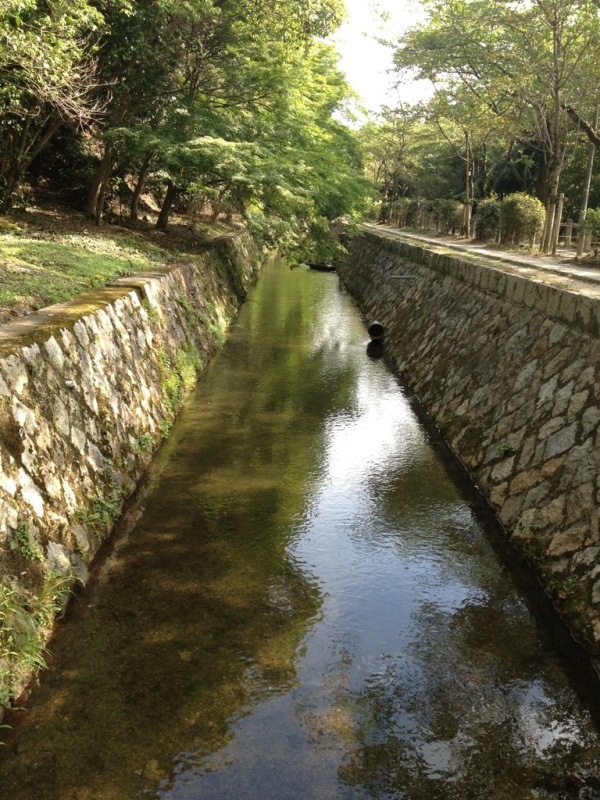[Kansai Travelog] Walking the Philosophers’ Way in Kyoto
August 18, 2012
I went to Kyoto for three days. It’s not far from Osaka, so I rode the train there in the morning and alighted at Kyoto station. The station turned out to be an attraction in itself. Over the main entrance is a web of steel beams, and a series of escalators takes you all the way up the side of the 12-story-plus building to a deck on the roof. On the tenth floor is Ramen Alley, where specialty ramens of different places are represented. I tried to eat there, but every shop had an unbelievable line, so I gave up. The other restaurants on the top of the building (actually an Isetan dept. store) were expensive, so I left my bag in a locker and rode the bus to Ginkakuji, the temple of the famed Silver Pavilion.
Ginkakuji and the Tea Well
Nowadays, the Golden Pavilion (Kinkakuji 金閣寺) is an internationally recognized symbol of Kyoto and Japan itself, but what of the Silver Pavilion, on the opposite Eastern Mountain side of Kyoto? The pavilion is not plated in silver, and unlike the Golden Pavilion, is a 15th-Century original wooden construction. (Kinkakuji was burned by an arsonist about 60 years ago.) Kyoto is large and traffic dense, so it took an hour to get uptown to Higashiyama, around Ginkakuji 銀閣寺. I ate oyako-don (chicken and egg over rice) for lunch on a street leading to the temple. Ginkakuji is not the official name of the temple, but most know it as the Temple of the Silver Pavilion. I paid 500 yen ($6) to enter with a huge crowd. We passed a bamboo hedge, and right on our right was the pavilion. The bottom is built in Japanese Shoin 書院style, and the top in Chinese temple style, with a phoenix on the roof. The date of construction was some time around 1400. In front of the temple is a garden of raked sand, and a cone of sand called the Moon-facing Platform. Up the hill was a little spring of clear water and algae called the Tea Well. The water from the well apparently has a good flavor favored by tea specialists, and the water from the well is used to make tea at government functions. A quiet garden led the way out, and I set off down the Philosophers’ Way.
The Philosophers’ Way and Honen’in Temple
Yamazaki and his wife recommended me the Philosophers’ Way, a path lined with cherry trees that leads south from Ginkakuji toward Kiyomizu Temple. After being jostled by crowds in Ginkakuji, a stroll along the river on the stone path was a welcome respite. A café I passed boasted coffee made with water from the temple’s well. At times I was alone on the path, and at times I passed others walking their way. The Way is so named because great scholars of the past were said to amble along the riverbank lost in thought. The trees grew thick on the other bank and hung low their leaves on the water, quite like Suzhou or Ito, and I was quite taken by the mosaic of greens and rocks and stream. I came upon Honen’in Temple 法然院, where Yamazaki said I could find a hint of the old Kyoto. Unlike Ginkakuji, Honen’in was free, not crowded, and set back in the woods of sight. The buildings lacked illustrious pedigrees, but the setting was right for relaxation. A sign before the moss-covered straw roof entry gate read in Classical Chinese, Pungent foods, spices, alcohol and meat may not enter this gate. Inside, on either side of the path were raised platforms of sand with designs formed on top. I’d never seen such artwork before and don’t know what they mean. Great vines grew on the trees over the water, and a pamphlet advertised a lecture titled, Let’s talk with the monks about nuclear power.
Futher down the path, I visited Otoyo Shrine, where a fox and mouse shrine stand side by side (technically an Inari and a Taikoku shrine).
Eikando Temple and the Lake Biwa aqueduct
Before Eikando Temple 永観堂 (officially called Zenrinji 禅林寺) was a sign with a quote: Respect humanity and morality, keep courtesy and moderation, use no martial force, and all under heaven will be in accord. (仁徳を尊び、礼節を守り、武力を用いず、天下和順なれ。)
Eikando’s autumn leaves are famous, and even in this late summer some were starting to redden. I walked among the centuries-old wooden buildings. Some parts of Eikando have been rebuilt more recently, as it suffered during the haibutsu-kishaku 廃仏毀釈 period during the late 19th Century when Buddhism was briefly outlawed, but even the elevator blended nicely with the old wood. I went up to see the tower, a famous spot for watching the sunset. The tower faces west, toward the Pure Land, so when the sun sets one can look out at the faraway Paradise and dream of the afterlife. A story associated with Eikando says that the founder of the sect was pacing in the temple in the cold early morning, chanting Amida’s name, when the statue of the Buddha Amida stepped down from its platform and walked with him. He stopped dead in his tracks. Amida turned his head and said, Eikan, you’re slow! Thus, to preserve that most beautiful profile of Amida, Eikan carved a statue of the Buddha looking over his shoulder than can still be seen in the hall.
Around Nanzenji Temple I saw the Lake Biwa aqueduct, which was built of brick about 100 years ago to bring water from Lake Biwa to Kyoto. I walked along as the water sped down the canal, until I came to a hydraulic station in an old stone-carved western-style building. I took the subway back to get my bag and spent the night in a hostel.
-Kieran
No comments yet















